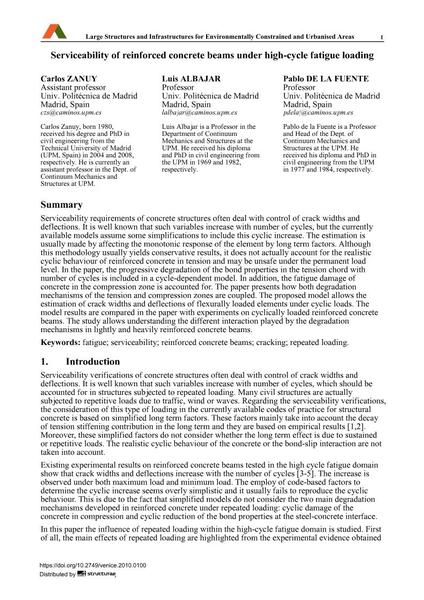Serviceability of reinforced concrete beams under high-cycle fatigue loading

|
|
|||||||||||
Détails bibliographiques
| Auteur(s): |
Carlos Zanuy
Luis Albajar Pablo De La Fuente |
||||
|---|---|---|---|---|---|
| Médium: | papier de conférence | ||||
| Langue(s): | anglais | ||||
| Conférence: | IABSE Symposium: Large Structures and Infrastructures for Environmentally Constrained and Urbanised Areas, Venice, Italy, 22-24 September 2010 | ||||
| Publié dans: | IABSE Symposium Venice 2010 | ||||
|
|||||
| Page(s): | 100-101 | ||||
| Nombre total de pages (du PDF): | 8 | ||||
| Année: | 2010 | ||||
| DOI: | 10.2749/venice.2010.0100 | ||||
| Abstrait: |
Serviceability requirements of concrete structures often deal with control of crack widths and deflections. It is well known that such variables increase with number of cycles, but the currently available models assume some simplifications to include this cyclic increase. The estimation is usually made by affecting the monotonic response of the element by long term factors. Although this methodology usually yields conservative results, it does not actually account for the realistic cyclic behaviour of reinforced concrete in tension and may be unsafe under the permanent load level. In the paper, the progressive degradation of the bond properties in the tension chord with number of cycles is included in a cycle-dependent model. In addition, the fatigue damage of concrete in the compression zone is accounted for. The paper presents how both degradation mechanisms of the tension and compression zones are coupled. The proposed model allows the estimation of crack widths and deflections of flexurally loaded elements under cyclic loads. The model results are compared in the paper with experiments on cyclically loaded reinforced concrete beams. The study allows understanding the different interaction played by the degradation mechanisms in lightly and heavily reinforced concrete beams. |
||||
